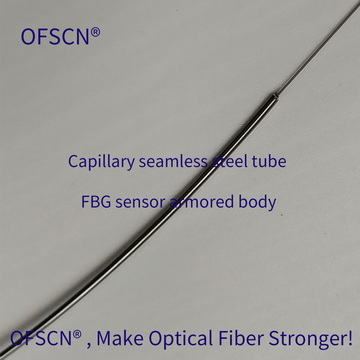The chemical industry involves numerous chemical reactions, and temperature monitoring is crucial to ensure the reactions proceed at the desired rate and avoid unwanted side reactions. Temperature monitoring also helps optimize reaction conditions, reduce production costs, and increase product quality. Fiber grating sensing technology offers a reliable and accurate way to monitor temperature changes in real-time.
Fiber grating sensing technology has become increasingly popular in the chemical industry due to its high accuracy, sensitivity, and reliability. Among the many applications of this technology, temperature monitoring of chemical reaction processes is particularly important. In this article, we will discuss the problems that fiber grating sensing technology can solve, and how Beijing Dacheng Yongsheng Technology Co., Ltd.(short for DCYS ) can support the temperature monitoring of chemical reaction process in the chemical industry.
Fiber Bragg Grating Sensing Principle:
Fiber Bragg gratings (FBGs) are periodic structures that are inscribed in the core of an optical fiber. These structures reflect a specific wavelength of light that is determined by the periodicity of the grating. When the grating is subjected to mechanical or thermal strain, the reflected wavelength changes in a predictable manner. By monitoring the reflected wavelength, changes in strain, temperature, and other parameters can be detected. FBG sensors can be used to monitor a wide range of parameters, including strain, stress, temperature, and vibration.
Click the link below for more details:
Demand Analysis for Temperature Monitoring of Chemical Reaction Process:
Temperature monitoring is essential for many chemical reaction processes in the chemical industry. In some cases, temperature monitoring is required by law or regulations to ensure environmental and worker safety. In other cases, temperature monitoring is necessary to optimize reaction conditions and reduce production costs.

Why Monitoring the Temperature of Chemical Reaction Processes is Needed:
Monitoring the temperature of chemical reaction processes is important for several reasons. Firstly, it allows us to ensure the reactions proceed at the desired rate and prevent unwanted side reactions. Secondly, it helps optimize reaction conditions, reduce production costs, and increase product quality. Thirdly, it is required by law or regulations to ensure environmental and worker safety.

Difficulties in Temperature Monitoring of Chemical Reaction Processes:
Temperature monitoring of chemical reaction processes in the chemical industry can be challenging due to various factors. For example, the reaction environment may be harsh or corrosive, which can damage or degrade the temperature sensors. In addition, traditional temperature sensors may not provide the required accuracy or sensitivity, leading to inaccurate temperature measurements
Recommended fiber grating temperature sensors:
What Problems can be Solved by FBG Sensing Technology:
Fiber grating sensing technology can solve many of the problems associated with traditional temperature sensors. Fiber grating sensors are immune to electromagnetic interference, chemical corrosion, and high temperatures. They also have high accuracy, sensitivity, and reliability, making them ideal for monitoring temperature changes in chemical reaction processes.

Beijing Dacheng Yongsheng Technology Co., Ltd.:
Beijing Dacheng Yongsheng Technology Co., Ltd.(short for DCYS) is a professional manufacturer of fiber grating sensors, fiber grating demodulators and system software. Specializing in the production of various fiber grating sensors, including temperature, strain, stress, displacement, vibration, shape sensors, etc. DCYS also produces fiber grating demodulators, and can customize and develop related application software.
Recommended fiber grating demodulator:
Product Alias: Fiber Bragg Grating Interrogator, FBG Interrogator, FBG Sensor Interrogator, Fiber Optic Grating Interrogator, Fiber Bragg Grating Demodulator, FBG Demodulator, Fiber Optic Grating Demodulator
This product is produced by DCYS, and it is a high-speed high-frequency fiber Bragg grating demodulator(Interrogator). The fiber grating demodulator is compatible with various specifications and models of OFSCN® fiber bragg grating sensors (temperature, strain, stress FBG sensors, etc.). It features adjustable port density (4, 8, 16 channels) and high-speed high-refresh rate capabilities.
DCYS Helps to Monitor the Temperature of Chemical Reaction Process:
DCYS can help solve some of the challenges associated with temperature monitoring of chemical reaction processes in the chemical industry. DCYS's fiber grating sensors are immune to harsh chemical environments and have high accuracy, sensitivity, and reliability. DCYS can provide customized solutions tailored to the specific needs of the chemical industry, such as temperature sensors with enhanced durability and resistance to harsh chemicals. Additionally, DCYS offers a range of fiber grating demodulators and software that can accurately and reliably process the temperature data collected by the sensors. With the help of DCYS, the chemical industry can improve temperature monitoring of chemical reaction processes, optimize reaction conditions, and reduce production costs, ultimately leading to improved product quality and increased efficiency.

Other Points Need to Be Clarified:
It is worth noting that temperature monitoring is just one aspect of process monitoring in the chemical industry. Other parameters such as pressure, flow rate, and chemical composition also play a critical role in optimizing reaction conditions and ensuring product quality. Fiber grating sensing technology can also be used to monitor these parameters, providing a comprehensive solution for process monitoring in the chemical industry.
In conclusion, fiber grating sensing technology offers numerous advantages for temperature monitoring of chemical reaction processes in the chemical industry. Beijing Dacheng Yongsheng Technology Co., Ltd. is a leading manufacturer of fiber grating sensors and solutions that can help solve some of the challenges associated with temperature monitoring in the chemical industry. By leveraging the benefits of fiber grating sensing technology, the chemical industry can optimize reaction conditions, improve product quality, and increase efficiency, ultimately driving growth and innovation in this important sector.
